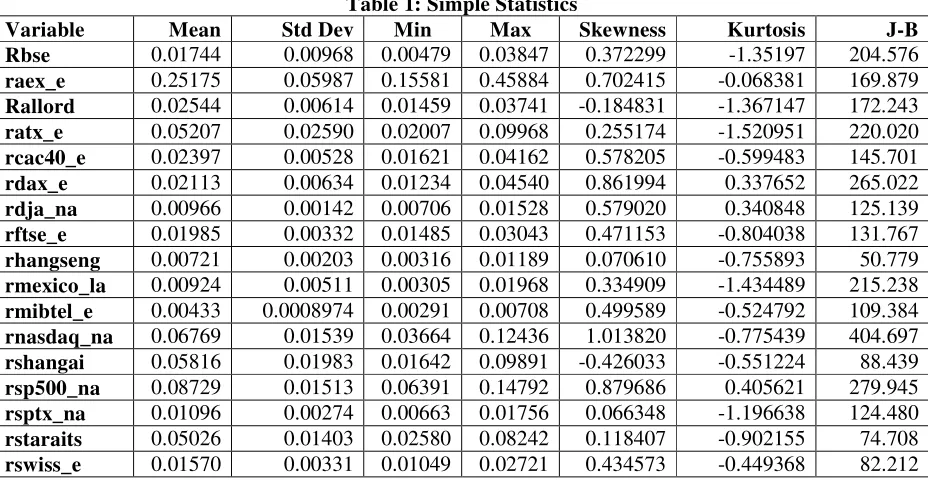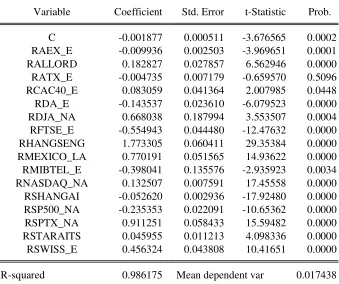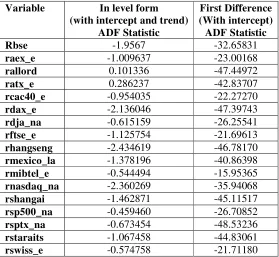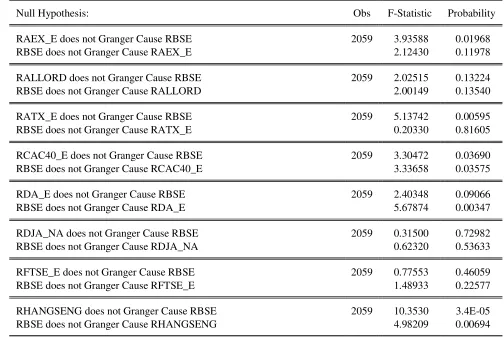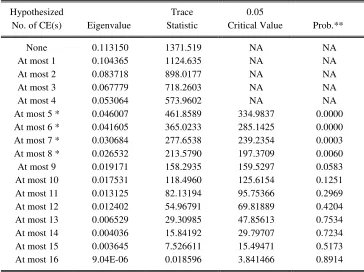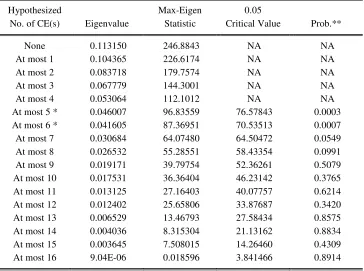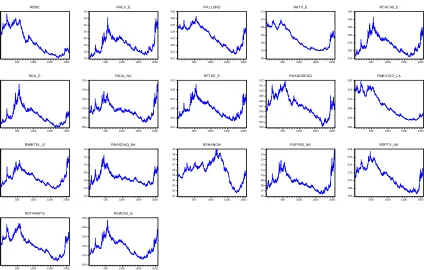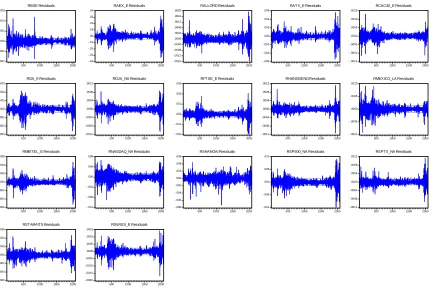Munich Personal RePEc Archive
Are stock exchanges integrated in the
world? - A critical Analysis
Vijay Kumar Varadi and Nagarjuna Boppana
University of Hyderabad
May 2009
Online at
http://mpra.ub.uni-muenchen.de/15902/
UNIVERSITY OF HYDERABAD
Are stock exchanges integrated in the world?
A critical analysis
Vijay & Dr. Boppana Nagarjuna
In the recent rapid reforms made the global into a global village in nature and in terms of efficiency, transparency. The information flow in one market may affect the other markets in the world, because of its integration. In this regard, this paper explores the objective whether there is any integration of markets taken place or not. For reaching the objective, we have used rigorous time series techniques for the equal
period of data (1st January, 2001 to 30th April, 2009) of 17 stock exchanges in the world, which includes
Is Stock Exchanges are integrated in the world – Critical Analysis
V.Vijay Kumar1 and Dr. Boppana Nagarjuna2
Introduction:
Economic reforms in the process of globalization positively changes in its nature of world stock
exchanges. Many research scholars would pose a question, is stock exchanges are become integrated in
the reform period. In the recent years, the world economies are moving its own dimension, is
experiencing a new kind of financial crisis with its integrity and efficiency. Recent years are evident to
stock exchanges, stock prices are falling drastically and majority of investment in stock market and its
allied services is evaporating and no idea how it makes people miserable.
The integration of stock exchanges produces a number of significant efficiency gains, some of which are
passed on by the exchanges to their users (intermediaries, investors and issuers) in the form of lower fees,
and some of which accrue directly to users. The integration of exchanges eliminates the duplication of
costly infrastructure, thus reducing the average cost of processing a trade. The competitive constraints
imposed by other trading mechanisms and the bargaining power of users induce the integrated exchange
to pass on those cost savings to its members by reducing trading fees. Final investors can then benefit
from this reduction in the explicit costs of trading in the form of lower brokerage fees.
Many researchers are found that co-integration among national stock markets may be implied by one or
more of the following factors: less cross-country restrictions on stock investment and foreign ownership.
A question then arises here: what kind of co-integration, linear or nonlinear, are these factors supposed to
result in? So far, all of the studies on international stock market integration that adopt cointegration
1
Research Scholar, Department of Economics, University of Hyderabad. [email protected]
2
analysis have taken the former for granted if cointegration is indeed present, while completely ignoring
the latter. Therefore, it is of importance to detect the possible existence of linear and nonlinear
cointegration among national stock markets.
However, the former studies specifies and estimates a nonlinear regression model without paying
attention to the possible non-stationarity of the regressand and the regressors that are the transformations
of the original time series. Thus the study is unable to cut loose from the problem of spurious regression
which cointegration techniques have been developed to overcome. In the latter study, the authors use the
original series and their cross-products and squares in the cointegration regression model after unit root
tests are applied to ensure that all the complex elements in the vector are integrated of the same order
(order one). Furthermore, the normality condition for employing the Johansen method is violated. Even
though the authors argue that no autocorrelation in the residuals is more important than the normality
condition, this does not mean that the latter is unimportant as finitesample critical values are computed
using normally distributed data.
In the theoretical literature, financial market integration derives from various postulates such as the law of
one price (Cournot (1927). Despite distinguishing features, these postulates share a common perspective:
if risks command the same price, then the correlation of financial asset prices and the linkage among
markets comes from the movement in the price of risks due to investors’ risk aversion. Based on these
theoretical postulates, financial integration at the empirical level is studied using several factors. Among
several others in the applied finance literature, have used the cointegration hypothesis to assess the
international integration of financial markets. Taylor and Tonks (1989) found that the cointegration
technique is useful from the perspective of the international capital asset price model. Kasa (1992)
suggested that the short-term return correlation between stock markets is not appropriate from the
The cointegration model is useful since it not only distinguishes between the nature of long-run and of
short-run linkages among financial markets, but captures the interaction between them as well. What is
striking about the empirical literature is that studies on the subject have brought to the fore various useful
perspectives relating to price equalisation, market equilibrium, market efficiency and portfolio
diversification (Chowdhry et al (2007)).
Harvey (1995) suggested that the improvement in market efficiency is consistent with increasing
integration with world markets. If markets are predictable and foreign investors are sophisticated, then
investors are likely to profit from the predictability of returns. Hassan and Naka (1996) suggest that in
cointegrated markets, price movements in one market immediately influence other markets, consistent
with efficient information sharing and free access to markets by domestic and foreign investors. Another
viewpoint is that national stock markets are different since they operate in the economic and social
environments of different countries. Accordingly, a country’s financial market is efficient when prices
reflect the fundamentals and risks of that country, rather than the fundamentals and risks of other
countries. Several studies have, however, argued that financial integration could occur due to real
economic interdependence or linkages among economic fundamentals across nations. For instance, the
profit and loss account and the balance sheet of a domestic company relying on a large volume of exports
and imports can be affected by the macroeconomic fundamentals of other countries.
Based on these considerations, the current paper attempts to detect non-linearity in the long-run
equilibrium relationship between several national stock markets. It is organized as follows.
Motivation of the study:
When we plot (Figure 1) the closing prices of different stock markets, we found the falling trend in all
markets at same point. It makes to go in deep, study about the reflection and affect of stock prices on
Objectives and Hypothesis:
This paper major objective is to understand the co-integration relationship between intra and inter stock
exchanges in the world and how they are integrated towards reaching the efficiency.
H0: Stock Markets are well co-integrated and leads to major fall or leads to financial crisis
H1: Otherwise
Data Sources:
World stock exchanges price series is collected and taken support from various data sources; such as
world stock exchanges, yahoo finance, BSE and its own stock exchanges for daily data of closing price
series for almost 25 major stock exchanges in the world. The data which includes ie., in Asia and Pacific
Markets we have Bombay Stock Exchange (BSE), All Ordinaries, Shangai, Hang Seng, Jakarta
Composite, KLSE, Nikkei 225, Staraits Times; in European Markets we have ATX (Vienna), CAC-40
(Paris), DAX, AEX –General (Amesterdom), MIBTEL (Milan), Swiss Market, FTSE 100; in Latin
American Markets we have MERVAL, Bovespa and IPC (Mexico) and in North American Markets
we have S&P TSX Composite, Dow Jones Index, S&P 500 index and Nasdaq-100.
Data:
The data we have considered in this paper is daily data for the period 1st January, 2001 to 30th April, 2009.
The data includes closing prices of the every stock market indices.
Methodology:
To study the above said objectives, I have followed the following methodology. First I have changed the
raw data into the return form for normalize the data. Then I have concentrated on descriptive statistics
i.e., Mean, standard deviation, minimum, maximum, skewness, kurtosis and J-B Statistic to know the
behavior of the data. After that, I just regress RBSE (return series of Bombay Stock Exchange) as a
taken place, but D-W statistics shows autocorrelation exists. I checked the correlation matrix for at what
stages all these variables correlated each other.
Although regression analysis deals with the dependence of the variable on other variables, it does not
necessarily imply causation. To find lag length of the variable, whether they have any unit root or
stationary, I have used ADF statistics with level form and ADF statistics with first difference, I found in
level form there is a unit root.
A Vector Error Correction Model:
The finding that many time series may contain a unit root has spurred the development of the theory of
non-stationary time series analysis. Engle and Granger (1987) pointed out that a linear combination of
two or more non-stationary series may be stationary. If such a stationary, linear combination exists, then
the non-stationary time series are said to be cointegrated. The stationary linear combination is called the
co-integrating equation and may be interpreted as a long-run equilibrium relationship between the
variables. Although the two series may be non stationary they may move closely together in the long run
so that the difference between them is stationary. The series RBSE and RAEX_E are said to be integrated
of the order one, denoted by I(1), if they become stationary after first difference. If there are two such
series which are I(1) integrated and their linear combination is stationary, then these two series are said to
be cointegrated. This relationship is the long run equilibrium relationship between RBSE and RAEX_E.
A principal feature of cointegrated variables is that their time paths are influenced by the extent of any
deviation from long-run equilibrium. If the system is to return to its long run equilibrium, the movement
of at least one variable must respond to the magnitude of the disequilibrium. If cointegration exists
between St and Ft, then Engle and Granger representation theorem suggests that there is a corresponding
Error Correction Model (ECM). In an ECM, the short term dynamics of the variables in the system are
The present research, seeks to determine whether there exists an equilibrium relationship between the
different indices. Engle and Granger suggest a four step procedure to determine if the two variables are
cointegrated. The first step in the analysis is to pre-test each variable to determine its order of integration,
as cointegration necessitates that the two variables be integrated of the same order. Augmented Dickey-
Fuller (ADF) test has been used to determine the order of integration. If the results in step one show that
both the series are I(1) integrated then the next step is to establish the long run equilibrium relationship in
the form
t t
t
RAEX
E
e
RBSE
=
β
0+
β
1_
+
Where RBSE is the log of Bombay stock exchange index; RAEX_E is the log of aex_E index prices at
time t and etis the residual term. In order to determine if the variables are cointegrated we need to
estimate the residual series from the above equation. The estimated residuals are denoted as (ê). Thus the
ê series are the estimated values of the deviations from the long run relationship. If these deviations are
found to be stationary, then the RBSE and RAEX_E series are cointegrated of the order (1,1). To test if
the estimated residual series is stationary Engle- Granger test for co-integration was performed.
The third step is to determine the ECM from the saved residuals in the previous step.
(
t t)
RBSE t tRBSE
e
lagged
RBSE
RAEX
E
RBSE
t=
α
1+
α
ˆ
1+
∆
,
∆
_
+
ε
,,∆
−(
t t)
RAEX Ett E
RAEX
e
lagged
RBSE
RAEX
E
E
EX
_
t 1 _ˆ
1,
_
_ ,A
=
α
+
α
+
∆
∆
+
ε
∆
−In the above equations,
t
RBSE
∆
andt E RAEX_
∆ denote, respectively, the first differences in the log of
spot and futures prices for one time period. eˆt−1is the lagged error correction term from the co-integrating
equation and
t RBSE,
ε
andt E RAEX_ ,
The above equations describe the short-run as well as long-run dynamics of the equilibrium relationship
between spot index and futures index. They provide information about the feedback interaction between
the two variables.
In the equation
t RBSE
∆ has the interpretation that, change in
t
RBSE
is due to both, short-run effects.From lagged futures and lagged spot variables and to the last period equilibrium error eˆt−1, which
represents adjustment to the long-run equilibrium. The coefficient attached to the error correction term
measures the single period response of changes in spot prices to departures from equilibrium. If this
coefficient is small then spot prices have little tendency to adjust to correct a disequilibrium situation.
Then most of the correction will happen in the other index prices.
The last step involves testing the adequacy of the models by performing diagnostic checks to determine
whether the residuals of the error correction equations approximate white noise. The reverse
representation of Engle and Granger’s Co-integration analysis along with the empirical findings has been
given in the appendix. A pair wise Granger Causality test was done to establish the cause and effect
relationship between the different series.
For causality, we have used Granger causality test which assumes that the information relevant to the
prediction of the respective variables. The test involves estimating the following regressions:
t j t m j j i t m i i t n i n
j t j t
i t i t
u
RBSE
E
AEX
E
AEX
u
RBSE
E
AEX
RBSE
2 1 11 1 1
_
_
_
+
∑
+
∑
=
∑
+
∑
+
=
− = − = = − = −δ
λ
α
Where it is assumed that the disturbances
u
1t andu
2t are uncorrelated.Results Discussion:
As we discussed earlier, the simple/ descriptive statistics reveals (Table 1) that all series of indices
measure of the center of the distribution of the series. Whereas, standard deviation is the measure of
degree of desperation of the data from the mean value, it indicates form the table spread exists in all
indices. Skewness is a measure of symmetry. In the given table, except rallord, rshagai (negative
skewness having left tail) all are having positive skewness, but rnasdaq_na is having positive skewness
i.e., (1.013) which indicates a long right tail exists. Kurtosis is a measure of whether the data are peaked
or flat relative to a normal distribution i.e, k=3. But in the given indices there is no such series are to be
seen. But, all the indices are negative excess kurtosis with having heavy peaked in its nature..
Table 1: Simple Statistics
Variable Mean Std Dev Min Max Skewness Kurtosis J-B
Rbse 0.01744 0.00968 0.00479 0.03847 0.372299 -1.35197 204.576
raex_e 0.25175 0.05987 0.15581 0.45884 0.702415 -0.068381 169.879
Rallord 0.02544 0.00614 0.01459 0.03741 -0.184831 -1.367147 172.243
ratx_e 0.05207 0.02590 0.02007 0.09968 0.255174 -1.520951 220.020
rcac40_e 0.02397 0.00528 0.01621 0.04162 0.578205 -0.599483 145.701
rdax_e 0.02113 0.00634 0.01234 0.04540 0.861994 0.337652 265.022
rdja_na 0.00966 0.00142 0.00706 0.01528 0.579020 0.340848 125.139
rftse_e 0.01985 0.00332 0.01485 0.03043 0.471153 -0.804038 131.767
rhangseng 0.00721 0.00203 0.00316 0.01189 0.070610 -0.755893 50.779
rmexico_la 0.00924 0.00511 0.00305 0.01968 0.334909 -1.434489 215.238
rmibtel_e 0.00433 0.0008974 0.00291 0.00708 0.499589 -0.524792 109.384
rnasdaq_na 0.06769 0.01539 0.03664 0.12436 1.013820 -0.775439 404.697
rshangai 0.05816 0.01983 0.01642 0.09891 -0.426033 -0.551224 88.439
rsp500_na 0.08729 0.01513 0.06391 0.14792 0.879686 0.405621 279.945
rsptx_na 0.01096 0.00274 0.00663 0.01756 0.066348 -1.196638 124.480
rstaraits 0.05026 0.01403 0.02580 0.08242 0.118407 -0.902155 74.708
rswiss_e 0.01570 0.00331 0.01049 0.02721 0.434573 -0.449368 82.212
The correlation matrix (table 2) reveals that, there is a positive correlation between Bombay
stock exchange index with other indices. Bombay stock index is having positive i.e., nearer to
one relationship is having allord, atx_e, sptx_na, stratits. And positive with greater than 0.5
indices are cac40_e, dax_e. dja_na, ftse_e, mibtel, nasdaq, sp500_na and swiss_e. But there is
Table 2: Cross correlations: For all Markets
RBSE RAEX_E RALLORD RATX_E RCAC40_E RDA_E RDJA_NA RFTSE_E RHANG RMEX RMIB RNASDAQ RSHANGAI RSP500_NA RSPTX_NA RSTARAITS RSWISS_E RBSE 1 0.216 0.914 0.936 0.536 0.648 0.673 0.593 0.904 0.980 0.559 0.631 0.295 0.608 0.926 0.898 0.641 RAEX_E 0.216 1 0.496 0.257 0.914 0.795 0.718 0.861 0.527 0.168 0.864 0.681 0.367 0.769 0.508 0.537 0.837 RALLORD 0.914 0.496 1 0.913 0.734 0.787 0.810 0.778 0.926 0.917 0.759 0.694 0.412 0.760 0.968 0.953 0.805 RATX_E 0.936 0.257 0.913 1 0.541 0.577 0.735 0.610 0.855 0.943 0.622 0.614 0.139 0.688 0.904 0.908 0.642 RCAC40_E 0.536 0.914 0.734 0.541 1 0.940 0.831 0.963 0.768 0.492 0.942 0.831 0.403 0.865 0.758 0.761 0.957 RDA_E 0.648 0.795 0.787 0.577 0.940 1 0.778 0.923 0.832 0.617 0.843 0.807 0.522 0.778 0.815 0.798 0.930 RDJA_NA 0.673 0.718 0.810 0.735 0.831 0.778 1 0.870 0.841 0.646 0.871 0.885 0.382 0.980 0.827 0.889 0.872 RFTSE_E 0.593 0.861 0.778 0.610 0.963 0.923 0.870 1 0.808 0.554 0.928 0.858 0.379 0.901 0.801 0.815 0.970 RHANG 0.904 0.527 0.926 0.855 0.768 0.832 0.841 0.808 1 0.864 0.774 0.807 0.485 0.797 0.946 0.952 0.827 RMEX 0.980 0.168 0.917 0.943 0.492 0.617 0.646 0.554 0.864 1 0.513 0.567 0.295 0.569 0.911 0.881 0.605 RMIB 0.559 0.864 0.759 0.622 0.942 0.843 0.871 0.928 0.774 0.513 1 0.802 0.318 0.902 0.779 0.799 0.928 RNASDAQ 0.631 0.681 0.694 0.614 0.831 0.807 0.885 0.858 0.807 0.567 0.802 1 0.342 0.915 0.760 0.784 0.829 RSHANGAI 0.295 0.367 0.412 0.139 0.403 0.522 0.382 0.379 0.485 0.295 0.318 0.342 1 0.286 0.410 0.374 0.382 RSP500_NA 0.608 0.769 0.760 0.688 0.865 0.778 0.980 0.901 0.797 0.569 0.902 0.915 0.286 1 0.788 0.844 0.887 RSPTX_NA 0.926 0.508 0.968 0.904 0.758 0.815 0.827 0.801 0.946 0.911 0.779 0.760 0.410 0.788 1 0.962 0.828 RSTARAITS 0.898 0.537 0.953 0.908 0.761 0.798 0.889 0.815 0.952 0.881 0.799 0.784 0.374 0.844 0.962 1 0.838 RSWISS_E 0.641 0.837 0.805 0.642 0.957 0.930 0.872 0.970 0.827 0.605 0.928 0.829 0.382 0.887 0.828 0.838 1
Table 3: Regression results
Dependent Variable: RBSE Method: Least Squares Sample: 1 2061
Included observations: 2061
Variable Coefficient Std. Error t-Statistic Prob.
C -0.001877 0.000511 -3.676565 0.0002
RAEX_E -0.009936 0.002503 -3.969651 0.0001
RALLORD 0.182827 0.027857 6.562946 0.0000
RATX_E -0.004735 0.007179 -0.659570 0.5096
RCAC40_E 0.083059 0.041364 2.007985 0.0448
RDA_E -0.143537 0.023610 -6.079523 0.0000
RDJA_NA 0.668038 0.187994 3.553507 0.0004
RFTSE_E -0.554943 0.044480 -12.47632 0.0000
RHANGSENG 1.773305 0.060411 29.35384 0.0000
RMEXICO_LA 0.770191 0.051565 14.93622 0.0000
RMIBTEL_E -0.398041 0.135576 -2.935923 0.0034
RNASDAQ_NA 0.132507 0.007591 17.45558 0.0000
RSHANGAI -0.052620 0.002936 -17.92480 0.0000
RSP500_NA -0.235353 0.022091 -10.65362 0.0000
RSPTX_NA 0.911251 0.058433 15.59482 0.0000
RSTARAITS 0.045955 0.011213 4.098336 0.0000
RSWISS_E 0.456324 0.043808 10.41651 0.0000
Adjusted R-squared 0.986067 S.D. dependent var 0.009678
S.E. of regression 0.001142 Akaike info criterion -10.70320
Sum squared resid 0.002667 Schwarz criterion -10.65676
Log likelihood 11046.65 F-statistic 9113.088
Durbin-Watson stat 0.166991 Prob(F-statistic) 0.000000
The regression results (table 3) reveal that, majority of the variables are significant at 1% level, even
though there is high t-statistic evidence this and also r-square, adjusted r-square is also evidence the same
picture about the results. But when we look at the D-W stat with 0.166991 indicates, the regression is
having a spurious regression i.e., having high t-values, high r-square and adjusted r-square and F-statistic .
It indicates that there is a non-stationary occurs among the series. However, that the long-term
information contained in levels time series will be lost after the differencing. To avoid loss of long-term
information, the majority of economists insisted on working with levels instead of differences.
Table 4: Augmented Dickey Fuller Test Statistic
Variable In level form
(with intercept and trend) ADF Statistic
First Difference (With intercept) ADF Statistic
Rbse -1.9567 -32.65831
raex_e -1.009637 -23.00168
rallord 0.101336 -47.44972
ratx_e 0.286237 -42.83707
rcac40_e -0.954035 -22.27270
rdax_e -2.136046 -47.39743
rdja_na -0.615159 -26.25541
rftse_e -1.125754 -21.69613
rhangseng -2.434619 -46.78170
rmexico_la -1.378196 -40.86398
rmibtel_e -0.544494 -15.95365
rnasdaq_na -2.360269 -35.94068
rshangai -1.462871 -45.11517
rsp500_na -0.459460 -26.70852
rsptx_na -0.673454 -48.53236
rstaraits -1.067458 -44.83061
rswiss_e -0.574758 -21.71180
Critical values in level form -3.9625 at 1%, -3.4119 at 5%, and -3.1279 at 10%
An augmented Dickey Fuller (ADF) test with 4 lags of the dependent variable in a regression equation on
the return data series with a intercept and trend, results indicate that the test statistic less than the crucial
values in the level form at least at 10% level. But, if I repeat the same process in the first difference with
intercept not with trend, all series are exceeds the test statistic critical values. So the null hypothesis of a
unit root in the all the series cannot be rejected. The test statistic is more negative than the critical value
and hence the null hypothesis of a unit root in the returns is convincingly rejected. Since the dependent
variable in this regression is non-stationary, it is not appropriate to examine the coefficient standard errors
or their ratios. Unit roots can be obtained by estimating the shift dates running a properly augmented
Dickey–Fuller (ADF) regression (Table 4); the critical values depend on the shift dates and the power of
the tests declines as the maximum number of allowed shifts (which is assumed to be known) increases.
Table 5: Pair-wise Granger Causality Tests
Null Hypothesis: Obs F-Statistic Probability
RAEX_E does not Granger Cause RBSE 2059 3.93588 0.01968
RBSE does not Granger Cause RAEX_E 2.12430 0.11978
RALLORD does not Granger Cause RBSE 2059 2.02515 0.13224
RBSE does not Granger Cause RALLORD 2.00149 0.13540
RATX_E does not Granger Cause RBSE 2059 5.13742 0.00595
RBSE does not Granger Cause RATX_E 0.20330 0.81605
RCAC40_E does not Granger Cause RBSE 2059 3.30472 0.03690
RBSE does not Granger Cause RCAC40_E 3.33658 0.03575
RDA_E does not Granger Cause RBSE 2059 2.40348 0.09066
RBSE does not Granger Cause RDA_E 5.67874 0.00347
RDJA_NA does not Granger Cause RBSE 2059 0.31500 0.72982
RBSE does not Granger Cause RDJA_NA 0.62320 0.53633
RFTSE_E does not Granger Cause RBSE 2059 0.77553 0.46059
RBSE does not Granger Cause RFTSE_E 1.48933 0.22577
RHANGSENG does not Granger Cause RBSE 2059 10.3530 3.4E-05
RMEXICO_LA does not Granger Cause RBSE 2059 11.6726 9.1E-06
RBSE does not Granger Cause RMEXICO_LA 9.18103 0.00011
RMIBTEL_E does not Granger Cause RBSE 2059 2.13096 0.11899
RBSE does not Granger Cause RMIBTEL_E 3.49238 0.03061
RNASDAQ_NA does not Granger Cause RBSE 2059 1.88499 0.15209
RBSE does not Granger Cause RNASDAQ_NA 2.24799 0.10587
RSHANGAI does not Granger Cause RBSE 2059 2.07382 0.12597
RBSE does not Granger Cause RSHANGAI 2.68248 0.06863
RSP500_NA does not Granger Cause RBSE 2059 0.46386 0.62892
RBSE does not Granger Cause RSP500_NA 0.10915 0.89661
RSPTX_NA does not Granger Cause RBSE 2059 1.77191 0.17027
RBSE does not Granger Cause RSPTX_NA 9.27591 9.8E-05
RSTARAITS does not Granger Cause RBSE 2059 0.49231 0.61129
RBSE does not Granger Cause RSTARAITS 8.81523 0.00015
RSWISS_E does not Granger Cause RBSE 2059 1.34510 0.26074
RBSE does not Granger Cause RSWISS_E 1.75901 0.17247
Causality between any pair of variables there is a possibility of unidirectional causality or
bidirectional causality or none. The primary-condition for applying Granger Causality test is to
ascertain the stationarity of the variables in the pair. The second requirement for the Granger
Causality test is to find out the appropriate lag length for each pair of variables.
For this purpose, we used the vector auto regression (VAR) lag order selection. Finally, the result
of Granger causality test is reported in table 5. There is a unidirectional causal influence between
Indian stock indices and AEX, ATX_E, Hangseng, Mexico_LA, Mibtel, Shangai, Staraits. There
is no causal relationship between Indian stock indices and Allord, DJA_NA, FTSE_E,
SP500_NA. But there is bi-directional causal relationship between CAC40_E, DAX_E,
NASDAQ_NA, SPTX_NA and SWISS_E. The present study found that direction of causality is
Co-integration test results:
The valuable contribution of the concepts of unit root, co-integration, etc., is to force us to find
out if the regression residuals are stationary. In the language of co-integration theory, a
regression known as co-integration regression and the parameter is known as the co-integrating
parameter. As the unit root tests try to examine the presence of stochastic trend of time series, co
integration tests search for the presence of a common stochastic trend among the variables from
the unit root test results, the required condition for co integration test that given series are not I
(O) is satisfied. At levels all the variables are non-stationary, where as first differenced
stationary. Majority of the cases, if two variables that are I(1) are linearly combined, then the
combination will also be I(1). In general, if variables with difference orders of integration are
combined, the combination will have an order of integration equal to the largest.
A set of variables is defined as co-integrated if a linear combination of them is stationary. Many
time series are non-stationary but ‘move together’ over time – that is, there exist some influences
on the series, which imply that the series are bound by some relationship in the long run. A
co-integration relationship may also be seen as a long-term or equilibrium phenomenon, since it is
possible that co-integrating variables may deviate from their relationship in the short run, but
their association would return in the long run (Chris Brooks, 1995).
To analyze long run relationship between Indian stock Market and other stock markets, Johansen
co-integration model has adopted. For testing co-integration, there are two test statistics to use.
First, trace statistics and other is Maximum Eigen value statistics. The results are shown in table
5. An empirical result of trace statistic indicates that the rejection of null hypothesis at 0.05
long relationship with other markets. Trace test also indicates that four co-integration equations
at 1% level and one co-integration equation at 5 % level of significance, tells about long run
equilibrium between Bombay stock exchange and other markets.
Table 6: Multivariate co-integration Unrestricted Rank Test (Trace)
Hypothesized Trace 0.05
No. of CE(s) Eigenvalue Statistic Critical Value Prob.**
None 0.113150 1371.519 NA NA
At most 1 0.104365 1124.635 NA NA
At most 2 0.083718 898.0177 NA NA
At most 3 0.067779 718.2603 NA NA
At most 4 0.053064 573.9602 NA NA
At most 5 * 0.046007 461.8589 334.9837 0.0000
At most 6 * 0.041605 365.0233 285.1425 0.0000
At most 7 * 0.030684 277.6538 239.2354 0.0003
At most 8 * 0.026532 213.5790 197.3709 0.0060
At most 9 0.019171 158.2935 159.5297 0.0583
At most 10 0.017531 118.4960 125.6154 0.1251
At most 11 0.013125 82.13194 95.75366 0.2969
At most 12 0.012402 54.96791 69.81889 0.4204
At most 13 0.006529 29.30985 47.85613 0.7534
At most 14 0.004036 15.84192 29.79707 0.7234
At most 15 0.003645 7.526611 15.49471 0.5173
At most 16 9.04E-06 0.018596 3.841466 0.8914
**MacKinnon-Haug-Michelis (1999) p-values
Similarly, the empirical results of Maximum Eigen value are shown in the table 6. The empirical
result indicates that the rejection of null hypothesis at 0.05 critical value i.e. no-co integration
vector. It also tells that Bombay stock exchange have long run equilibrium with other markets.
Maximum Eigen value indicates that two co-integration equations at 1% and one co-integration
Table 7: Multivariate Unrestricted Cointegration Rank Test (Maximum Eigenvalue)
Hypothesized Max-Eigen 0.05
No. of CE(s) Eigenvalue Statistic Critical Value Prob.**
None 0.113150 246.8843 NA NA
At most 1 0.104365 226.6174 NA NA
At most 2 0.083718 179.7574 NA NA
At most 3 0.067779 144.3001 NA NA
At most 4 0.053064 112.1012 NA NA
At most 5 * 0.046007 96.83559 76.57843 0.0003
At most 6 * 0.041605 87.36951 70.53513 0.0007
At most 7 0.030684 64.07480 64.50472 0.0549
At most 8 0.026532 55.28551 58.43354 0.0991
At most 9 0.019171 39.79754 52.36261 0.5079
At most 10 0.017531 36.36404 46.23142 0.3765
At most 11 0.013125 27.16403 40.07757 0.6214
At most 12 0.012402 25.65806 33.87687 0.3420
At most 13 0.006529 13.46793 27.58434 0.8575
At most 14 0.004036 8.315304 21.13162 0.8834
At most 15 0.003645 7.508015 14.26460 0.4309
At most 16 9.04E-06 0.018596 3.841466 0.8914
Empirical analysis Error Correction Mechanism:
From the above analysis, it has explained that, Indian capital market has long run relationship
with other developing markets. But that does not mean they have short run equilibrium. There
may exists short run dynamics among capital markets. For taking care of short run equilibrium
Error Correction Mechanism (ECM) has been adopted. ECM empirical results have shown in the
table (6). Indian capital market and Australian capital market has taken into consideration.
Empirical result shows that coefficient of difference closing price ATX-100 is non-zero that
means difference closing price Sensex is out of equilibrium. Since co-efficient of lagged residual
is negative, the term θut-1is negative. Therefore, the dependent variable X is also negative to
falling in the next period to correct the equilibrium error. Empirical result also finds that Indian
capital market adjusts to change in Australian capital market have a positive impact on short-run
changes. Similarly, in case of UK, Japan and France, short run changes in the capital market has
positive impact on short-run changes in Indian capital market except USA capital market which
has shown negative impact on short run changes in Indian capital market.
Vector Error Correction estimates
Cointegrating Eq: CointEq1
RBSE(-1) 1.000000
RAEX_E(-1) 0.055373
(0.02067)
[ 2.67931]
RALLORD(-1) -1.091942
(0.21132)
[-5.16732]
RATX_E(-1) -0.035879
(0.05483)
[-0.65437]
RCAC40_E(-1) 1.890385
(0.38265)
[ 4.94027]
RDA_E(-1) 0.121756
(0.19005)
[ 0.64063]
RDJA_NA(-1) 1.606171
(1.40853)
[ 1.14032]
RFTSE_E(-1) 0.842189
(0.35916)
[ 2.34490]
RHANGSENG(-1) -2.511124
(0.46817)
[-5.36375]
RMEXICO_LA(-1) 0.008306
(0.40725)
[ 0.02039]
RMIBTEL_E(-1) 2.219601
(1.07268)
[ 2.06921]
RNASDAQ_NA(-1) -0.297622
[-5.12900]
RSHANGAI(-1) 0.044028
(0.02170)
[ 2.02881]
RSP500_NA(-1) -0.192976
(0.16733)
[-1.15324]
RSPTX_NA(-1) 1.558806
(0.45090)
[ 3.45713]
RSTARAITS(-1) -0.010596
(0.08544)
[-0.12402]
RSWISS_E(-1) -4.050963
(0.35075)
[-11.5495]
C 0.008051
Figure 1: Return values of different stock indices
.004 .008 .012 .016 .020 .024 .028 .032 .036 .040
500 1000 1500 2000
RBSE .15 .20 .25 .30 .35 .40 .45 .50
500 1000 1500 2000
RAEX_E .012 .016 .020 .024 .028 .032 .036 .040
500 1000 1500 2000
RALLORD .00 .02 .04 .06 .08 .10 .12
500 1000 1500 2000
RATX_E .015 .020 .025 .030 .035 .040 .045
500 1000 1500 2000
RCAC40_E .012 .016 .020 .024 .028 .032 .036 .040 .044 .048
500 1000 1500 2000
RDA_E .006 .008 .010 .012 .014 .016
500 1000 1500 2000
RDJA_NA .012 .016 .020 .024 .028 .032
500 1000 1500 2000
RFTSE_E .003 .004 .005 .006 .007 .008 .009 .010 .011 .012
500 1000 1500 2000
RHANGSENG .000 .004 .008 .012 .016 .020
500 1000 1500 2000
RME XICO_LA .002 .003 .004 .005 .006 .007 .008
500 1000 1500 2000
RMIBT EL_E .02 .04 .06 .08 .10 .12 .14
500 1000 1500 2000
RNASDAQ_NA .01 .02 .03 .04 .05 .06 .07 .08 .09 .10
500 1000 1500 2000
RSHANGAI .06 .07 .08 .09 .10 .11 .12 .13 .14 .15
500 1000 1500 2000
RSP500_NA .006 .008 .010 .012 .014 .016 .018
500 1000 1500 2000
RSPTX_NA .02 .03 .04 .05 .06 .07 .08 .09
500 1000 1500 2000
RSTARAITS .008 .012 .016 .020 .024 .028
500 1000 1500 2000
Figure 2: Residual series of stock indices -.002 -.001 .000 .001 .002 .003
500 1000 1500 2000
RBSE Residuals -.04 -.03 -.02 -.01 .00 .01 .02 .03 .04
500 1000 1500 2000
RAEX_E Residuals -.0016 -.0012 -.0008 -.0004 .0000 .0004 .0008 .0012 .0016 .0020
500 1000 1500 2000
RALLORD Residuals -.006 -.004 -.002 .000 .002 .004 .006
500 1000 1500 2000
RATX_E Residuals -.0015 -.0010 -.0005 .0000 .0005 .0010 .0015
500 1000 1500 2000
RCAC40_E Residuals -.003 -.002 -.001 .000 .001 .002 .003
500 1000 1500 2000
RDA_E Residuals -.0012 -.0008 -.0004 .0000 .0004 .0008 .0012
500 1000 1500 2000
RDJA_NA Residuals -.002 -.001 .000 .001 .002 .003
500 1000 1500 2000
RFTSE_E Residuals -.0012 -.0008 -.0004 .0000 .0004 .0008 .0012
500 1000 1500 2000
RHANGSENG Residuals -.0010 -.0005 .0000 .0005 .0010
500 1000 1500 2000
RMEXICO_LA Residuals -.0006 -.0004 -.0002 .0000 .0002 .0004 .0006
500 1000 1500 2000
RMIBTEL_E Residuals -.012 -.008 -.004 .000 .004 .008
500 1000 1500 2000
RNASDAQ_NA Residuals -.008 -.006 -.004 -.002 .000 .002 .004 .006
500 1000 1500 2000
RSHANGAI Residuals -.010 -.005 .000 .005 .010
500 1000 1500 2000
RSP500_NA Residuals -.0012 -.0008 -.0004 .0000 .0004 .0008 .0012
500 1000 1500 2000
RSPTX_NA Residuals -.006 -.004 -.002 .000 .002 .004 .006
500 1000 1500 2000
RSTARAITS Residuals -.0020 -.0015 -.0010 -.0005 .0000 .0005 .0010 .0015
500 1000 1500 2000
RSWISS_E Residuals
Figure 3: Co-integration analysis for the above said equation
-.03 -.02 -.01 .00 .01 .02
250 500 750 1000 1250 1500 1750 2000
Concluding Remarks:
This paper empirically investigates the long run equilibrium relationship between the Indian
stock market and the stock market indices of five developed countries as a using the multivariate
co integration. The multivariate co integration technique is used to investigate the long run
relationship. To assess the short run influence of one market on the other and to assess how many
days each market takes to factor out the influence Indian market, we have used the granger
causality test with two days.
The study concludes, that India and other countries markets highly co integrating during the
period of the study. Financial integration is key to delivering competitiveness, efficiency and
growth. But Is integration brings financial stability? Not necessarily. As it indicates that, the
integration of markets may also have positive impact of financial crisis which happened all over
References:
Bekaert G. and Harvey C.R. (1995): Time Varying World Market Integration: Journal of Finance. 50. pp 403-414.
Chowdhry, T, Lin Lu and Ke Peng (2007): “Common stochastic trends among Far astern stock prices: effects of Asian financial crisis”, International Review of Financial Analysis, vol 16.
Cournot, Augustin (1927): Researches into the Mathematical Principles of the Theory of Wealth, Nathaniel T Bacon (trans), Macmillan.
Hassan, M K and A Naka (1996): “Short-run and long-run dynamic linkages among international stock markets”, International Review of Economics and Finance, vol 5, no 1.
Kasa, K (1992): “Common stochastic trends in international stock markets”, Journal of Monetary Economics, vol 29, pp 95–124.
Kim, E Han and V Singhal (2000): “Stock market opening: experience of emerging economies”, Journal of Business, vol 73, pp 25–66.
